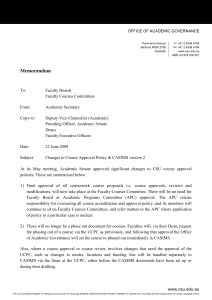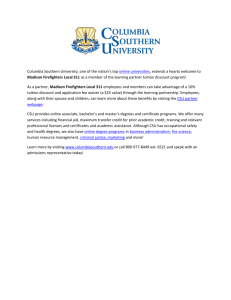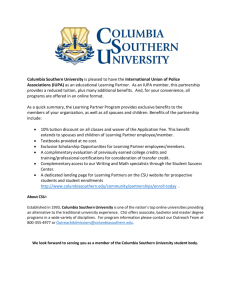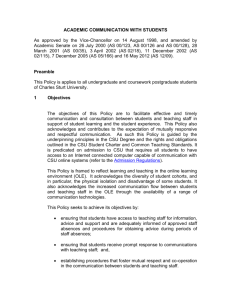the analysis as a Word file. - CSU Thinkspace
advertisement
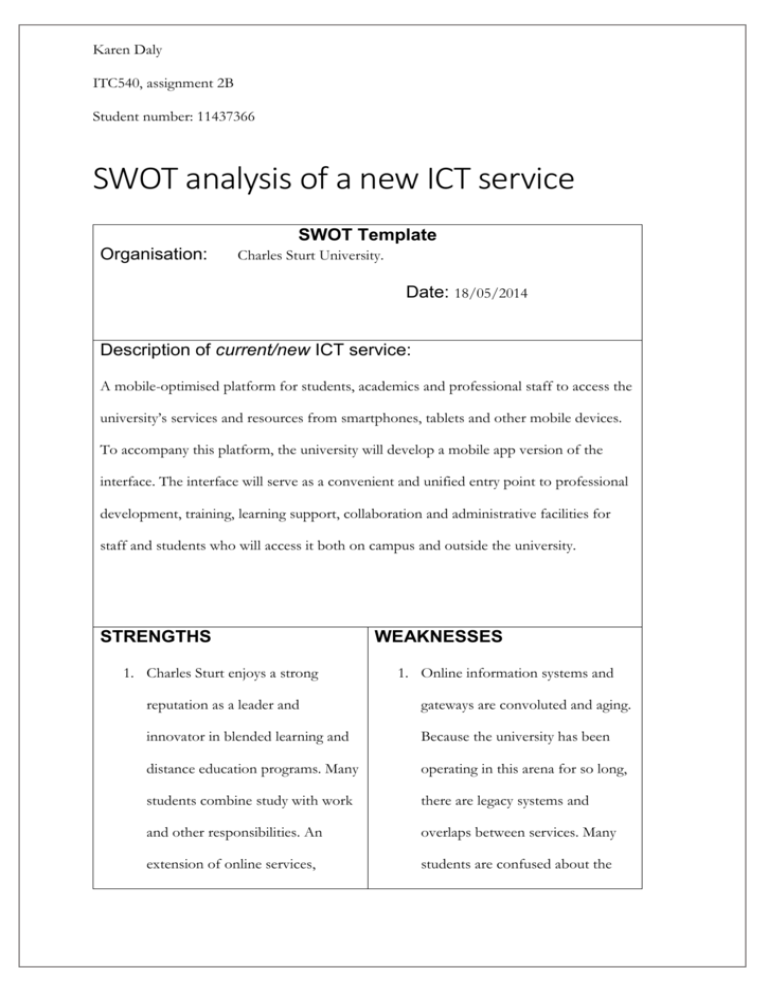
Karen Daly ITC540, assignment 2B Student number: 11437366 SWOT analysis of a new ICT service SWOT Template Organisation: Charles Sturt University. Date: 18/05/2014 Description of current/new ICT service: A mobile-optimised platform for students, academics and professional staff to access the university’s services and resources from smartphones, tablets and other mobile devices. To accompany this platform, the university will develop a mobile app version of the interface. The interface will serve as a convenient and unified entry point to professional development, training, learning support, collaboration and administrative facilities for staff and students who will access it both on campus and outside the university. STRENGTHS 1. Charles Sturt enjoys a strong WEAKNESSES 1. Online information systems and reputation as a leader and gateways are convoluted and aging. innovator in blended learning and Because the university has been distance education programs. Many operating in this arena for so long, students combine study with work there are legacy systems and and other responsibilities. An overlaps between services. Many extension of online services, students are confused about the Karen Daly ITC540, assignment 2B Student number: 11437366 especially one which enhances the differences between different convenience of studying CSU portals. Any new interface must be subjects, will further cement this interoperable with existing systems reputation and may improve but also adjustable to systems CSU retention or even recruitment of introduces in the future. students. 2. The university already possesses 2. CSU does not have sufficient IT personnel to devote a team extensive mobile infrastructure (a exclusively to the development and LMS, student and staff portals, an maintenance of a new information established presence on social system for the long term. networking and other digital 3. Mobile devices are accessible to services) and has been offering many students but the university online education programs for a lacks the internal infrastructure to considerable time, with third-party support the modes of learning applications like WordPress and available through mobile YouTube already incorporated into technologies and for the time being many teaching and research is dependent on third-party services programs. This expertise and like YouTube and Vimeo for experience reduce the prospective uploading content (Klapdor, 2014). training burden for IT and 4. Greater use of mobile devices on academic staff alike. A high speed campus for tasks users might have wireless network with its own completed on desktops and laptops configuration tool covers all puts pressure on CSU’s wireless Karen Daly ITC540, assignment 2B Student number: 11437366 campuses of the university and the network, potentially causing delays university is also a member of the and forcing the university to add Eduroam program, giving staff and capacity. students wireless access when they are on the campuses of other universities (Charles Sturt University, 2014a). 3. Staff are actively engaged in researching mLearning innovations and best practices. The mLearn project has been running for a number of years (Charles Sturt University, 2012). 4. CSU’s large contingent of distance education students and its geographically dispersed students and researchers are used to seeing the web as their main channel of communication with the university and, as a result, are better primed to adopt a new application than the communities of other institutions. Karen Daly ITC540, assignment 2B Student number: 11437366 5. The CSU library has already developed its own mobile app, ahead of the libraries of other Australian institutions (Charles Sturt University Division of Library Services, 2014a; Stone, 2013). Databases and other resources subscribed to by the library have inbuilt mobile apps and functionality and can be integrated into the new mobile interface, along with other products and third-party services operating throughout teaching, research and administrative departments (such as Yammer, PebblePad and Microsoft Communicator). OPPORTUNITIES 1. The computing market is moving THREATS 1. The rate of innovation in the increasingly toward mobile mobile computing market means computing and the next wave of that it is difficult to anticipate the tablets and netbooks are being devices (or, indeed, browsers and Karen Daly ITC540, assignment 2B Student number: 11437366 heavily marketed to students as operating systems) with which staff providing functionality, portability and students will be accessing the and price savings compared to network in the future and whether traditional laptops and desktops any one application will be (Charles Sturt University, 2012). interoperable with these devices. Further, the increase in students 2. If apps and services by vendors attending university from lower and outside companies (such as SES backgrounds is likely to database aggregators) are contribute to a decrease in incorporated into the platform, ownership of laptops and a changes vendors make to their corresponding rise in the interfaces and apps may impact the proportion of smaller screen and functionality of the CSU platform. mobile devices being used to access Many of these apps and services university networks and complete are important for student study and assignments (Charles Sturt staff research and users would University, 2012). CSU can be expect to be able to access them. certain that the majority of students 3. Increasing competition in distance will be able to access mobile education from overseas services without the loan of a institutions as well as institutions device provisioned by the within Australia produces a student university (although such a market which is more discerning program will still be necessary). and demanding about the quality of the student experience, including Karen Daly ITC540, assignment 2B Student number: 11437366 2. Mobile devices raise the prospect the online student experience, of more innovative learning and putting additional pressure on assessment activities for all universities to develop and students but particularly for maintain high quality, engaging and distance education students and accessible interfaces. Fourteen students engaged in workplace other Australian Universities learning. Mobile devices can also already utilise iTunesU to provide be used for data collection, data access to mobile materials and access and other research activities institutions such as the Universities by staff while travelling or away of Sydney and Melbourne boast from campus, the new interface mobile apps with LMS integration expediting the storage and (Charles Sturt University, 2012). organisation of information for CSU has significant numbers of staff and students alike. The higher international students in its quality of new smartphone screens distance education programs and makes the experience of content partner institutions in Asia, Europe and media more engaging (Turban, and the Pacific. Overseas Volonino and Wood, 2013). competitors offer sophisticated 3. Staff and students across campuses mobile learning programs, some of and locations might collaborate which are being released free of through video conferencing and charge on MOOC platforms like other collaborative apps included in Coursera and edX. These programs the platform, sharing expertise and platforms raise students’ Karen Daly ITC540, assignment 2B Student number: 11437366 across the institution and reducing expectations of mobile learning the costs involved in transporting services further still. staff to physical meetings. 4. The consumerisation of workplace 4. User privacy cannot be guaranteed for external apps (such as Vimeo technology (especially the BYOD) and twitter) integrated into the trend means that students and university’s platform (Klapdor, many staff members will prefer 2014). CSU must rely upon their own devices to university students and staff to create their supplied equipment, leading to own accounts and manage their potential hardware savings for CSU own privacy settings for these if these are not overtaken by the services. Many users will cost of an increased load on the nevertheless expect support in wireless network. using these apps from the university and may hold the university responsible for damage to their own equipment. 5. Although the ownership of smartphones is accelerating at an unprecedented rate, CSU cannot assume that all students have access to a device. Even more pivotally, we cannot assume that students have access to high-speed Karen Daly ITC540, assignment 2B Student number: 11437366 wireless networks at all times. Many phone users rely on 3G or older networks and have limited data allowances (Klapdor, 2014). Summary and Recommendations: Mobility presents challenges and opportunities for universities across the world, extending the reach of institutions like CSU and at the same time transforming the expectations students and staff have of their relationship with education providers and employers. Over a number of years CSU has been exploring mobility’s impact on education from multiple angles through its mLearn project (Charles Sturt University, 2012). As the biggest provider of distance education in Australia with a uniquely dispersed student population studying a wide range of subject areas, CSU would seem poised to avail itself of the opportunities brought into being by the swift pace of innovation in the mobile computing market, the accompanying shifts in consumer preferences and the more flexible and engaging interfaces being developed for mobilebased learning and research. Largely based on Web 1.0 technologies, the existing portal, intranet and website appear “flat” compared to the dynamic, Web 2.0-enabled sites students and staff experience outside the university and lack the tools for communication and collaboration featured by these outside sites in particular. By establishing a mobile-optimised platform as a single entry point to university resources and services and by making that platform available as a mobile app, CSU can achieve its strategic goals of strengthening its position as a leader in flexible and blended Karen Daly ITC540, assignment 2B Student number: 11437366 learning and teaching with a particular focus on professional education, advancing the applied research in which the university specialises and improving the student experience, as well as achieving efficiencies in the collection and maintenance of data and the coordination of administrative processes (Charles Sturt University, 2010). Moreover, the opening up of the higher education market with further deregulation from 2012 has put an even greater emphasis on student experience. In this climate universities will distinguish themselves by optimising their learning and teaching environments, especially through educational technology (Charles Sturt University, 2010). The mobile interface project will be managed in an agile manner that is responsive to the emergence of new technologies, feedback from users and data analytics, preferring a simple and sustainable design delivered rapidly. The success of the project hinges upon users’ access to support mechanisms as much as their access to technology (Charles Sturt University, 2012). In comparison to CSU’s redevelopment of its Interact LMS (analysed in the first assignment), this project introduces a new IT infrastructure instead of updating or adapting an existing architecture, however both projects seek to provide a single point of access to disparate information systems within the university, integrating materials which have often been created without consistent standards. Both applications also respond to the boom in ownership of tablets, smartphone and other mobile devices and a corresponding demand from students and workers for flexibility in study and work arrangements The mobile platform presents a unique opportunity to promote greater use of CSU’s existing mobile applications by making them more accessible and findable with a single Karen Daly ITC540, assignment 2B Student number: 11437366 entry point. Like the Interact redevelopment, it leverages CSU’s experience and expertise in blended learning to secure a competitive advantage in the distance education market through an enhanced user experience and the streamlining of processes. Work by other universities (most notably Oxford University with its open source mobile app) diffuses some of the development costs for CSU, as was the case with the Sakai software implemented in the first version of Interact, however there is no ready-made support community or documentation for CSU’s final product in this case. Above all, the mobile interface project demonstrates how integral an enterprise architecture practice is to IT governance in a large and complex organisation like a university, especially a university which has distributed its teaching and research functions across several regions, serving widely dispersed staff and students. The guidance of the university’s Enterprise Architecture and Liaison office (http://www.csu.edu.au/division/dit/eal/architectures.htm) in the initial planning, design and implementation will ensure that the new service is effectively integrated with existing information systems, especially the university’s learning management and student records systems, but it is the ongoing involvement of this office that will ultimately guarantee that each change to and iteration of the service is effectively coordinated with other university processes and systems at the same time as it responds to information about user needs garnered from data analytics. Short Term (Now) The Enterprise Architecture and Liaison office will have oversight over the initial research and planning period, owing to the complexity of the task of integrating any new Karen Daly ITC540, assignment 2B Student number: 11437366 system with the university’s current network and the need to align the development of the system with long-term goals. An initial investigation and survey will involve staff from most divisions and sections of the university and particularly the division of student learning, IT and library and student services in order to ensure that the project will not be siloed and will support strategic goals as they are realised across the university. The priorities for the beginning of the project are to identify the functionalities and generic capabilities for learning and teaching which should be included as priorities in the mobile app and the interface, to work with IT staff to stabilise rich media delivery (vodcasts and podcasts) to mobile devices accessing the network and website, to promote and raise awareness of existing CSU mobile apps such as PebblePad and the Interact podcasting tool and to research the interoperability of internal and third partypublished content with the mobile interfaces available from LMS vendors like Blackboard and Moodle. Deciding between an open source or a commercial solution is a key objective of the initial research and planning phase. Of particular importance will be the extent of the IT staffing and resources that must be diverted to support an open source application and how this compares to the extra cost of a commercial product with vendor support. Finally, data analytics applications will be applied to measure how many students and staff are accessing the site with mobile devices at present and whether their behaviour and interests differ significantly from users accessing the site from more traditional machines. Mid Term (next 12 months) Karen Daly ITC540, assignment 2B Student number: 11437366 Over the medium term, the implementation plan expands into several pilot programs, tendering and negotiation processes and user experience studies. After the initial study and survey of staff and students, the enterprise architect responsible for the project will need to investigate the offerings of various external vendors and the level of support they are able to extend to the initial implementation and from hence to the maintenance of the system over its lifetime. Customisation, scalability and flexibility will also be prominent criteria in the assessment of vendors’ offerings, along with interoperability with applications the university may add to its network in the future and new technologies staff and students may adopt to access the network. While there is a risk of lock-in with a single vendor approach, this approach also simplifies development and support (Charles Sturt University, 2012). During the configuration and installation phase, university staff (including enterprise architects) will work closely with representatives from the vendor to verify that the requirements and specifications determined from the initial studies are met by the final product. Alongside the configuration and installation of the software, staff will develop a mobile hub (mHub) to promote and support the service, addressing issues of technical support, training and user buy in. Eventually, mHub will become an open and collaborative space to disseminate and share resources, reviews, guides, tutorials and other information regarding hardware, software and uses of mobile technologies (Charles Sturt University, 2012). Available to students, staff, researchers and professional staff across the sector with no internal log-in required, mHub will consolidate CSU’s position as an industry leader in mobile learning and draw public attention to its work with the new mobile interface (Charles Sturt University, 2013). Karen Daly ITC540, assignment 2B Student number: 11437366 Because there is no clear precedent for mobile learning, the leaders of the project will gain real world experience through small, tightly focused pilot programs enlisting staff who are willing to incorporate a pilot version of the interface into their teaching, with training and support for pilot participants provided by the project team (Charles Sturt University, 2012). The small scale of these pilots will allow team members to quickly ascertain what does and does not work with minimal risk and to acquire a stronger understanding of how to support the services when they are rolled out more widely (Charles Sturt University, 2012). There will also be a pilot of CSU-provisioned devices on campus to examine how devices are supported by the existing infrastructure. Infrastructure planning will be revised as these devices are trialled in and rolled out to further sections of the organisation. In the medium term, a beta version of the interface and app will be created by mobilising less demanding content (such as subject outlines, campus maps with location-aware promotions, calendars and the message centre). Launching this simplified version of the mobile app through iTunes and the Google Play store will help to ascertain the level of student interest and the services which generate the most user interaction (Charles Sturt University, 2014c). Also in the medium term, CSU will establish a presence on prominent and easily implemented outside educational platforms like iTunesU. Long Term (next 3 to 5 years) The university’s Enterprise Architecture and Liaison office has a lifetime commitment to the service, beyond its inception. Over the long term, staff from the office will review the Karen Daly ITC540, assignment 2B Student number: 11437366 service periodically to assess how it aligns with strategic goals in the university’s educational technology plan, with major reviews accompanying the release of each updated plan every three years. The design process for a service such as this is iterative and ongoing, reflecting a need to continually innovate, revise the design and information architecture and add functionality in response to user needs and disruptive transformations in the mobile computing market. In the longer term, the success of the project will be decided by the effectiveness of university-wide IT governance in maintaining consistent data storage and use policies across departments and divisions so that all systems are interoperable with the mobile platform. The task of navigating between the viewpoints of different departments and user groups whilst at the same time maintaining the highest standards of functionality and user accessibility will draw upon the enterprise architect’s full complement of interdisciplinary skills in project management, IT and communication. The most crucial task over the next three to five years will be the integration of Interact into the mobile platform, with work at other universities (UCT and Oxford) serving as models (Charles Sturt University, 2012). This integration will have been piloted in a limited number of subjects in the first year of the project and these pilots will continue. Among other concerns, the team will consider whether it is prudent for the system to continue to rely upon third-party apps such as YouTube and Yammer or if it is in fact feasible for the university to develop or lease apps for common functions like image sharing and storage and video conferencing. Use of all third-party applications and social media must conform to the university policy on external educational applications (Charles Sturt University, 2014c). Karen Daly ITC540, assignment 2B Student number: 11437366 Finally a learning analytics strategy will be formulated so that staff have actionable data for evaluating the take up of the application, whether it is used equally by all groups and, most vitally, users’ interaction with its resources. The resulting aggregated analytic data will provide prompts to improve performance without breaching students’ privacy by storing personally identifiable information. References Brann, J., Uys, P., Griffin, L., Klapdor, T., Thomson, S., Fell, R., . . . Harris, M. (2011). Mobile learning initiative investigation report. Retrieved from Charles Sturt University website: http://www.csu.edu.au/__data/assets/word_doc/0008/202103/2011MobileLearningIn itiativeInterimReport.docx Charles Sturt University. (2010). CSU educational technology framework. http://www.csu.edu.au/division/landt/resources/documents/CSUEducationalTechnol ogyFramework.pdf Charles Sturt University. (2011). CSU educational technology plan, 2011-2013. Charles Sturt University. (2012). mLearn 2012: Lessons through exploration. Retrieved from SlideShare website: http://www.slideshare.net/mLearn/mlearn-fullreport Charles Sturt University. (2013). mHub website. from http://mhub.csu.edu.au/ Charles Sturt University. (2014a). Wireless guide. http://www.csu.edu.au/division/dit/services/service-catalogue/wireless/ Charles Sturt University. (2014b). Dashboard of CSU educational technologies. Charles Sturt University. (2014c). mLearn: Mobile learning at CSU. Karen Daly ITC540, assignment 2B Student number: 11437366 http://www.csu.edu.au/division/landt/resources/mobilelearning Charles Sturt University Division of Library Services. (2014a). Mobile information. http://www.csu.edu.au/division/library/how-to/csu-library-mobile Charles Sturt University Division of Library Services. (2014b). Mobile devices for study and research. Google Inc. . (2014). Google Analytics: Official website. from http://www.google.com.au/analytics/ Klapdor, T. (2014). Smart phone to smart students. Retrieved from mHub website: http://mhub.csu.edu.au/mlearn/smart-phones-to-smart-students/ Stone, R. (2013). What’s mobile at CSU? Retrieved from mHub website: http://mhub.csu.edu.au/guides/whats-mobile-at-csu/ Turban, E., Volonino, L., & Wood, G. (2013). Information technology for management: Advancing sustainable, profitable business growth. . Hoboken, NJ: Wiley.
